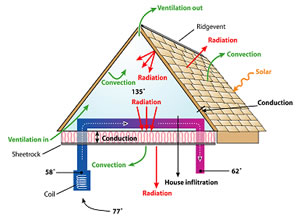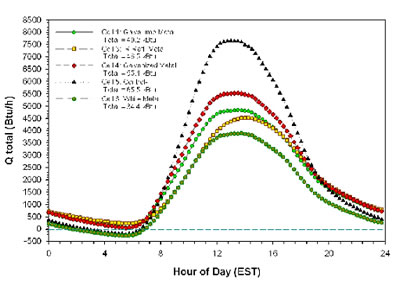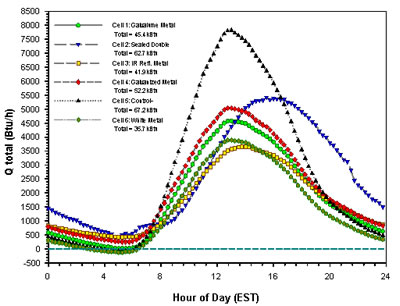- Reflective Roofing Research
|
Figure 72 Vented attic thermal processes. |
Improving
attic thermal performance is fundamental to controlling residential
cooling loads in hot climates. Research shows that the influence
of attics on space cooling is not only due to the change
in ceiling heat flux, but often due to the conditions within
the attic, and their influence on duct system heat gain and
building air infiltration. (Figure 72)
The importance of ceiling heat flux has long been recognized,
with insulation a proven means of controlling excessive gains.
However when ducts are present in the attic, the magnitude
of heat gain to the thermal distribution system can be much
greater than the ceiling heat flux. This influence may be
exacerbated by the location of the air handler within the
attic space - a common practice in much of the southern US.
Typically an air handler is poorly insulated and has the
greatest temperature difference at the evaporator of any
location in the cooling system. It also has the greatest
negative pressure just before the fan so that some leakage
into the unit is inevitable.
The Flexible Roof Facility (FRF) is an FSEC test facility
designed to evaluate five roofing systems at a time against
a control roof with black shingles and vented attic (Figure
73).
5th
Budget Period Experiments
The testing evaluates how roofing systems impact summer
residential cooling energy use and peak demand. In the summer
of 2003, the roofing systems tested are listed in Table
45. Cell numbering is from left to right beginning with
the second cell in from the left.
Table
45 Roofing systems tested at the FSEC
Flexible Roofing
Facility, Summer of 2003 |
Cell # |
Description |
1 |
Galvalume®*
unfinished 5-vee metal with vented attic (2 nd year
of exposure) |
2 |
Sealed attic with proprietary
configuration |
3 |
High reflectance brown
metal shingle with vented attic |
4 |
Galvanized unfinished
5-vee metal with vented attic (2 nd year of exposure) |
5 |
Black shingles with standard
attic ventilation (Control Test Cell) |
6 |
standing seam metal with
vented attic (2 nd year of exposure after cleaning) |
* Galvalume
is a quality cold-rolled sheet to which is applied
a highly corrosion-resistant hot-dip metallic coating
consisting of 55% aluminum 43.4% zinc, and 1.6% silicon,
nominal percentages by weight. This results in a
sheet that offers the best protective features characteristic
of aluminum and zinc: the barrier protection and
long life of aluminum and the sacrificial or galvanic
protection of zinc at cut or sheared edges. According
to Bethlehem Steel, twenty-four years of actual outdoor
exposure tests in a variety of atmospheric environments
demonstrate that bare Galvalume sheet exhibits superior
corrosion-resistance properties. |
|
Figure 73 Flexible
Roof Facility
in summer of 2003 configuration. |
All had R-19 insulation installed on the attic floor except
in the configuration with the sealed attic (Cell #2) which
had R-19 of open cell foam sprayed onto the bottom of the
roof decking. The measured thermal impacts include ceiling
heat flux, unintended attic air leakage and duct heat gain.
Cell
#2 had a proprietary configuration which is not reported
upon in this report.
A
major thrust of the testing for 2003 was comparative testing
of metal roofing under long term exposure. Given the popularity
of unfinished metal roofs, we tested both galvanized and
Galvalume® roofs in their second year
of exposure. Galvalume® roofs are reported to better
maintain their higher solar reflectance than galvanized types.
Average daily mid-attic maximum temperatures for the Galvalume® and
galvanized metal roof systems showed significantly better
performance for Galvalume® product (17.5 oF and 13.1
oF cooler than the control dark shingle respectively).
|
Figure
74 Estimated combined
impact of duct heat
gain,air leakage from the attic
to conditioned space
and ceiling heat flux on space
cooling needs on an
average summer day in a 2,000
ft 2 home. |
Other
than the sealed attic case, the white metal roof results
in the coolest attic over the summer, with an average peak
of only 94.6 oF – 22.1 o cooler than the peak
in the control attic with dark shingles. The highly reflective
brown metal shingle roof (Cell #3) provided the next coolest
peak attic temperature. Its average maximum daily mid-attic
temperature was 101.5 oF (15.2 oF lower than the control
dark shingle cell). While the brown metal shingle roof’s
reflectance was lower than the two metal roofs and white
metal roof we observed evidence that the air space under
the metal shingles provides additional effective thermal
insulation.
We
also estimated the combined impact of ceiling heat flux,
duct heat gain and unintended attic air leakage from the
various roof constructions. All of the alternative constructions
produced lower estimated cooling energy loads than the standard
vented attic with dark shingles (Figure 74). The
Galvalume® roof clearly provided greater reductions to
cooling energy use than the galvanized roof after two summers
of exposure.
One
important fact from our testing is that nighttime attic
temperature and reverse ceiling heat flux have a significant
impact on the total daily heat gain, particularly for the
metal roofs. The rank order in Table 46 shows the percentage
reduction of roof/attic related heat gain and approximate
overall building cooling energy savings (which reflect
the overall contribution of the roof/attic to total cooling
needs):
Table 46
Roof cooling load reduction and overall
cooling savings,
Summer 2003 experiments |
Rank |
Description |
Roof
Cooling Load Reduction |
Overall
Cooling Savings |
1 |
White metal with vented
attic (Cell #6) |
47% |
15% |
2 |
High reflectance brown
metal shingle with vented attic (Cell #3) |
29% |
10% |
3 |
Galvalume® unfinished
metal with vented attic (Cell #1) |
25% |
8% |
4 |
Galvanized unfinished metal
roof with vented attic (Cell #4) |
16% |
5% |
The relative reductions are consistent with the whole-house
testing recently completed for FPL in Ft. Myers (Parker et
al., 2001). This testing showed white metal roofing having
the largest reductions, followed by darker constructions.
4th
Budget Period Experiments
|
Figure 75 Flexible Roof
Facility in
summer 2002 configuration. Cells are numbered
from left to right starting
with the second cell in
from the left. |
The
Flexible Roof Facility (FRF), located in Cocoa, Florida,
is designed to simultaneously evaluate five roofing systems
against a control roof with black shingles and vented attic. (Figure
75) The test evaluated how roofing systems impact summer
residential cooling energy use and peak demand. In the summer
of 2002, six roofing systems were evaluated as described
in Table 47.
Table
47 Roofing systems tested and associated energy
savings
at the
FSEC Flexible Roofing Facility, Summer of 2002
|
Cell # |
Roof Material |
Ventilation
|
Roof Cooling Load
Reduction |
Overall Cooling
Savings |
#1 |
Galvalume® unfinished
5-vee metal |
vented |
32% |
11% |
#2 |
double roof with radiant
barrier (ins roof deck) |
sealed |
7% |
2% |
#3 |
high reflectance ivory
metal shingle |
vented |
38% |
12% |
#4 |
galvanized unfinished
5-vee metal |
vented |
22% |
7% |
#5 |
black shingles (control
cell) |
vented |
control |
control |
#6 |
white standing seam metal |
vented |
7% |
2% |
All roof cells had R-19 insulation installed on the attic
floor, except the double roof configuration (Cell #2) which
had a level of R-19 open cell foam sprayed onto the bottom
of the roof decking. Measured thermal impacts included ceiling
heat flux, unintended attic air leakage, and duct heat gain.
The sealed attic double roof system (Cell #2) provided
the coolest attic space of all systems tested (average maximum
mid-attic temperature was 81.1 oF), and therefore had the
lowest estimated impact due to return air leakage and duct
conduction heat gains. However this cell also had the highest
ceiling heat flux of all strategies tested, and recorded
the most modest space cooling reduction (7%), relative to
the control roof.
Metal
roof testing was given more emphasis in 2002 due to the
popularity of these products. Researchers tested both galvanized
and Galvalume ® roofs. Galvalume is a cold-rolled
sheet with a highly corrosion-resistant hot-dip metallic
coating application of 55% aluminum 43.4% zinc, and 1.6%
silicon. These roofs are reported to better maintain solar
reflectance than galvanized roofing systems. Average daily
mid-attic maximum temperatures for the Galvalume ® and
galvanized metal roof systems were roughly similar (19.6
oF and 17.3 oF cooler than the control roof, respectively).
The estimated total heat gain for these roof cells also was
relatively close.
|
Figure 76 2002
estimated combined impact of duct heat
gain, air
leakage from the attic to conditioned space, and
ceiling heat flux on space cooling needs on an average |
The
highly reflective ivory metal shingle roof (Cell #3) provided
the coolest peak attic temperature of all the cells without
roof deck insulation. Its average maximum daily mid-attic
temperature was 93.3 oF (23.4 oF lower than the control
dark shingle cell). While the ivory metal shingle roof’s
reflectance was slightly lower than the two metal roofs and white metal roof,
researchers noted that the air space under the metal shingles provided additional
effective thermal insulation.
Researchers also estimated the combined impact of ceiling
heat flux, duct heat gain, and unintended attic air leakage
from the various roof constructions. All of the alternative
roofing treatments produced lower estimated cooling energy
loads than the standard vented attic with dark shingles. (Figure
76) The Galvalume® roof clearly provided a greater
cooling energy use reduction than the galvanized roof.
This also was true during the 2001 study. Nighttime attic
temperatures and reverse ceiling heat flux have a significant
impact on the total daily heat gain, particularly for metal
roofs.
3rd
Budget Period
|
Figure 77 2001 Experimental
roof cell.
Cells are numbered from left to right
starting
with the cell second in from the left |
In
the 2001 testing, Cell #2 with the double roof/sealed attic
showed the lowest attic temperatures and narrowest temperature
range. (Table 48; Figures 77 and 79) Peak attic
temperatures in Cell #2 were 5 oF to 6 oF lower than this
same sealed cell the year before, without the double roof.
This indicates that the double roof did provide a substantial
benefit. Since there is no insulation on the attic floor
though, there still is a significant heat gain across the
ceiling. In fact, the ceiling heat fluctuation actually is
higher than the reference Cell #5. (Figure 78)
The true impact of the double roof construction of Cell
#2 is most likely a combination of the benefits of a cooler
attic space that reduces duct heat gain and minimizes the
effects of air leakage from the attic into the house, and
the drawback of the higher ceiling heat flux.
Cell #3 with its spectrally selective dark brown metal
shingles, produced lower attic temperatures at night, but
higher roof deck temperatures (which were most likely due
to the insulating quality of the shingles which have an air
space underneath them).
Table
48 Roofing systems tested and attic temperatures
at the FSEC Flexible Roofing
Facility, Summer of 2001
|
Cell # |
Roof Material |
Ventilation
|
Avg Attic Temp |
Max Attic Temp |
#1 |
white tile (weathered) |
sealed |
84.6 |
111.2 |
#2 |
double roof with radiant
barrier (ins roof deck) |
sealed |
78.4 |
85.4 |
#3 |
brown IR selective metal
shingle |
vented |
85.0 |
110.8 |
#4 |
terra cotta tile (weathered) |
vented |
89.0 |
124.3 |
#5 |
dark shingles (control) |
vented |
91.0 |
143.4 |
#6 |
white standing seam metal
(weathered) |
sealed |
84.0 |
115.5 |
Roofing
Experiment with Habitat for Humanity in Fort Myers, Florida
In July 2000, FSEC and Florida Power and Light instrumented
six side-by-side Habitat for Humanity homes in Ft. Myers
with identical floor plans, orientation, and ceiling insulation,
but with different roofing systems as described in Table
49. A seventh monitored house contained an unvented
attic with insulation on the underside of the roof deck rather
than on the ceiling.
Each unoccupied home was monitored from July 8 through July
31, 2001 to collect building thermal and air conditioning
power data. Table 50 presents the cooling performance
of the roofing systems clearly showing the energy-saving
benefits of reflective roofing systems in Florida, especially
the tile and metal roofs with solar reflectance between 65%
and 75%.
Table
49 Roofing systems tested at side-by-side
Habitat for Humanity homes
in Ft. Myers Summer of 2000
|
Code |
Description |
Code |
Description |
RGS |
Standard dark shingles
(control) |
RTB |
Terra
cotta "barrel" S-tile
roof |
RWS |
Light colored shingles |
RWB |
White "barrel" S-tile
roof |
RWM |
White metal roof |
RWF |
White flat tile roof |
RSL |
Standard
dark shingles with sealed attic & R-19 roof deck
insulation |
|
Table
50 Energy use and savings from roofing systems in
Habitat for Humanity roofing
study, summer of 2000
|
Site |
Total kWh |
Savings kWh |
Saved Percent |
Demand kW |
Savings kW |
Saved Percent |
RGS |
17.03 |
---- |
---- |
1.63 |
---- |
---- |
RWS |
15.29 |
1.74 |
10.2% |
1.44 |
0.19 |
11.80% |
RSL |
14.73 |
2.30 |
13.05% |
1.63 |
0.01 |
0.30% |
RTB |
16.02 |
1.01 |
5.9% |
1.57 |
0.06 |
3.70% |
RWB |
13.32 |
3.71 |
21.8% |
1.07 |
0.56 |
34.20% |
RWF |
13.20 |
3.83 |
22.5% |
1.02 |
0.61 |
37.50% |
RWM |
12.03 |
5.00 |
29.4% |
0.98 |
0.65 |
39.70% |
Significant findings: Reflective roofing materials represent
one of the most significant energy-saving options available
to homeowners and builders. These materials also reduce cooling
demand during utility coincident peak periods, and are potentially
one of the most effective methods for controlling demand.
- Based on comparative data from August of 2000, the maximum
decking temperatures in the sealed attic home were 23 E
F higher than the control home (177 E versus 154 E ). After
the installation of white shingles in midsummer, the highest
deck temperature from the sealed attic home measured only
7 E higher than the control in August of 2001 (161 E versus
154 E ).
- An
additional month’s data was
collected with the homes occupied and thermostat set
points kept constant. Average cooling energy use for
the homes rose by 36%, but there was no decrease in the
highly reflective roofing system savings. Additional
heat gained from the occupants and their appliance use
increased the cooling system runtime and introduced more
hot air into the air conditioning duct system.
- In 2001, the average maximum attic air temperature in
the terra cotta barrel tile roof home was 15 E F hotter
than the maximum ambient. After installing a radiant barrier
the average difference in August was +9 E F. A similar
evaluation with the light colored shingles showed that
peak attic air temperatures dropped from + 29 E to +20
E F after installing a radiant barrier.
- Household interior temperature settings varied from
one year to the next, making direct energy saving comparisons
impossible. Still, the collected data did show that attic
air temperatures were reduced by the radiant barrier. On
the other hand, measured maximum plywood decking temperatures
rose by 11 E to 13 E F.
- Based on previously evaluated roof buckling problems
on the decking of the sealed attic home, researchers decided
to install white shingles similar to those on the RWS roof.
It was thought that buckling problems likely were caused
by excessive heat buildup in this roofing system. White
shingles replaced the dark shingles to see if this would
drop the roof decking temperature spikes.
|


 You
are here:
You
are here: 





